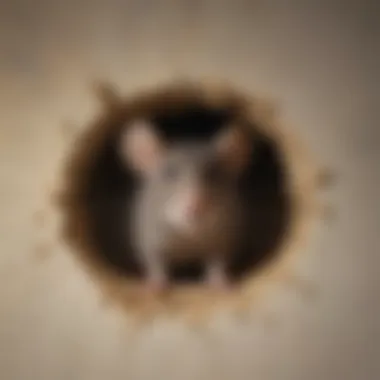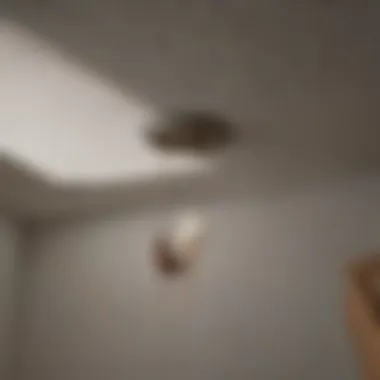Effective Strategies for Dealing with Rats in Your Ceiling


Preventive Pest Control Strategies
When it comes to keeping your home free from unwanted critters like rats, preventive pest control strategies play a vital role. Starting with the house's exterior protection, ensure you seal all cracks meticulously to prevent any sneaky entries for pests. Alongside this, clearing debris around your property helps eliminate hiding spots for potential intruders, while implementing measures to keep pests from entering your home is crucial.
In addition to focusing on the exterior, yard maintenance is essential. Adopting rigorous yard care routines such as regular mowing and trimming can deter pests from making themselves at home. Explore effective methods to keep your yard pest-free, safeguarding your outdoor space from potential infestations.
Moving indoors, prioritize cleanliness as a key defense against pests. Arm yourself with expert cleaning tips and techniques to maintain a pest-resistant indoor environment. By keeping your living spaces tidy and clutter-free, you create a less welcoming environment for rodents like rats.
Moreover, paying attention to garbage disposal practices is paramount. Efficient waste disposal methods not only contribute to a cleaner home but also play a significant role in deterring pests. Emphasize the importance of proper garbage disposal to mitigate pest infestations effectively.
Lastly, consider other innovative pest prevention strategies to safeguard your home comprehensively. Whether it's installing mesh screens, utilizing ultrasonic devices, or implementing natural repellents, explore different approaches to ward off potential invaders.
Identifying Pest Risk Areas
To effectively combat rat infestations, understanding and identifying pest risk areas are essential. Conduct thorough inspections of moisture-prone spots in your home to pinpoint potential problem areas. Implement strategies to prevent infestations by addressing damp conditions promptly.
Similarly, conduct crack and crevice inspections regularly to seal off access points for pests. By understanding the importance of maintaining these areas, you can enhance your home's defenses against rodents seeking shelter.
Furthermore, inspect the greenery around your property for pest risks. Certain plants and landscaping elements can attract pests, so familiarize yourself with guidelines to maintain a pest-free yard. By tackling potential attractants, you reduce the likelihood of rodent infestations.
Additionally, don't overlook miscellaneous pest risk areas in and around your home. From attic spaces to crawl spaces, identify and address these vulnerable points using preventive measures tailored to each area.
Effective Pest Control Methods
When faced with a rat infestation, deploying effective pest control methods becomes imperative. Explore natural repellents as a safe and eco-friendly solution to deter pests. Essential oils, herbs, and plants can serve as potent tools in repelling rodents from your property.
For a more hands-on approach, consider using chemical sprays cautiously for pest control. Safely eradicate pests using professional sprays while minimizing health risks to your family and the environment.
Additionally, utilizing pest traps offers a practical solution. Learn to set up and use traps effectively to capture and remove pests safely from your home. Incorporate biological control methods by introducing natural predators to manage pest populations organically.
Beyond traditional methods, explore innovative pest control solutions to combat rodent infestations effectively.
Pest Species Identification
Identifying the types of pests invading your home is crucial for targeted control measures. Recognize common insects like ants, cockroaches, and spiders that may infest your living spaces. Understand their behavior and preferred habitats to implement tailored pest management strategies.
When it comes to rodents, specifically mice and rats, swift identification is key. Learn to recognize signs of rodent presence and take proactive measures to prevent infestations before they escalate.
In addition to insects and rodents, be aware of bird species that can impact your home environment. Address bird-related issues promptly, especially concerning problematic species commonly found in residential areas.


Lastly, equip yourself to deal with wildlife encounters on your property effectively. Understand the behavior of wildlife species and employ control measures to mitigate potential conflicts and safeguard your home.
To wrap up, familiarize yourself with lesser-known pest species that may pose a threat to your home. By developing a comprehensive understanding of various pests, you can devise holistic pest management strategies tailored to specific species.
DIY Pest Control Techniques
For those keen on taking a hands-on approach to pest control, DIY techniques offer a practical solution. Experiment with homemade pest control solutions using eco-friendly remedies to combat pests effectively.
Leverage the power of essential oils for pest control by creating natural repellents that keep rodents at bay. Establish effective pest traps and barriers around your property to control and prevent infestations proactively.
Explore top reputable pest control brands offering products to manage pest infestations seamlessly. Implement these solutions to safeguard your home and loved ones from potential pest threats.
Roll up your sleeves and delve into miscellaneous DIY pest control techniques designed to address a range of pest issues at home. These unique solutions offer a personalized approach to combating pests and maintaining a pest-free living environment.
Understanding the Issue
In this section of the article, we delve into the crucial aspect of understanding the issue of rats in your ceiling. Acknowledging the signs of an infestation is paramount in taking necessary action to eradicate these unwanted pests from your home. By identifying the telltale markers of rat presence early on, homeowners can prevent further damage to their property and ensure a safe living environment for their families. Understanding the issue provides a solid foundation for effective pest control measures and minimizes the risks associated with rat infestations.
Signs of Rat Infestation
Scratching Noises
Scratching noises are a common indicator of a rat infestation in your ceiling. These sounds, typically heard at night, stem from rats' constant gnawing and movement. The distinct scratching sounds can alert homeowners to the presence of these rodents, prompting them to take prompt action to address the issue. Although unsettling, recognizing these noises early can help prevent extensive damage to structures and potential health risks associated with rat infestations.
Droppings
Finding droppings in your home is a clear sign of a rat infestation. Rat droppings are often scattered around feeding and nesting areas, indicating the extent of the infestation. Identifying and properly disposing of these droppings is crucial for maintaining a hygienic living space and preventing the spread of diseases carried by rats.
Gnaw Marks
Gnaw marks on various surfaces, such as walls, wires, and furniture, are additional signs of a rat infestation. Rats gnaw on objects to wear down their teeth, leading to visible marks that can help pinpoint their presence in your home. Recognizing these distinctive gnaw marks enables homeowners to take targeted measures to eliminate rats and secure their property against further damage.
Health Risks Associated
Diseases Transmitting
Rats are known carriers of various diseases, including leptospirosis, hantavirus, and salmonellosis, posing a significant health risk to humans. Understanding the diseases transmitted by rats underscores the importance of swift and effective pest control measures to safeguard your family's well-being. By addressing rat infestations promptly, homeowners can mitigate the spread of pathogens and reduce the likelihood of disease transmission within their homes.
Allergic Reactions


In addition to transmitting diseases, rat infestations can trigger allergic reactions in susceptible individuals. Rat dander and urine can exacerbate respiratory issues and allergies, leading to discomfort and health complications. Recognizing the allergic risks associated with rat infestations highlights the need for proactive pest control strategies to minimize exposure and maintain a safe indoor environment.
Reasons for Infestation
Food Sources
Availability of food sources, such as unsecured pantry items and food residue, attracts rats into homes. Understanding the role of food sources in rat infestations emphasizes the importance of proper food storage and waste management practices to deter these pests. By eliminating access to food, homeowners can reduce the likelihood of infestations and create an inhospitable environment for rats.
Entry Points
Rats gain entry into homes through small openings and cracks in foundations, walls, and roofs. Identifying and sealing potential entry points is essential in preventing rats from infiltrating your living spaces. By securing these vulnerable areas with appropriate materials and techniques, homeowners can fortify their homes against rat infestations and protect their property from structural damage.
Taking Action
Taking action is a crucial step when dealing with rats in your ceiling. Ignoring the problem can lead to further damage and health risks within your household. By proactively addressing the issue, you can safeguard your home and family. This section will guide you through the necessary steps to effectively remove rats from your ceiling and prevent future infestations.
Inspection and Identification
Locating Entry Points
Locating entry points is vital in understanding how rats are accessing your ceiling. By identifying these entry points, you can block off access and prevent rats from entering your home. The key characteristic of this process is its precision in determining potential vulnerable areas where rats may sneak in. This proactive approach is essential for maintaining a rat-free environment. Locating entry points allows you to take targeted action to secure your home effectively.
Assessing Damage
When assessing damage caused by rats in your ceiling, you can gauge the extent of the infestation and identify areas that require immediate attention. The key characteristic of this process lies in its ability to reveal the impact of rat activity in your home. Assessing damage helps in strategizing your removal and prevention methods. While it highlights the severity of the situation, it also empowers you to tailor your approach for maximum effectiveness.
Sealing Entry Points
Materials Needed
Having the right materials is essential for sealing entry points effectively. Materials like steel wool, caulk, and wire mesh are popular choices for blocking rat access. The key characteristic of these materials is their durability and ability to withstand pest intrusion. By using quality materials, you ensure long-lasting protection against rat infestations. Their unique features include resistance to gnawing and weather elements, making them ideal for this purpose.
Techniques
Employing the right techniques for sealing entry points is crucial in preventing rats from re-entering your home. From properly sealing gaps to installing barriers, these techniques aim to create a rat-proof environment. The key characteristic of these techniques is their meticulous approach to covering all possible entryways. By implementing these techniques, you can fortify your home against future rat intrusions. Their unique feature lies in their comprehensive coverage, leaving no room for pests to find a way in.
Trapping and Removal
Types of Traps


Choosing the right types of traps is essential for effectively removing rats from your ceiling. Snap traps, live traps, and electronic traps are popular choices for capturing rats. The key characteristic of these traps is their efficiency in catching pests swiftly. By selecting the appropriate trap type based on your situation, you maximize the chances of successful removal. Their unique feature lies in their targeted approach to eliminating rat populations without harming other wildlife.
Safe Removal Practices
Practicing safe removal methods is crucial for both your safety and the well-being of the rats. Using humane traps and protective gear ensures a safe removal process. The key characteristic of safe removal practices is their emphasis on compassion and non-violence towards animals. By following these practices, you can remove rats from your home without causing unnecessary harm. Their unique feature lies in their ethical approach to pest control, promoting a harmonious coexistence between humans and wildlife.
Prevention and Maintenance
Prevention and maintenance play a crucial role in effectively dealing with rats in your ceiling. By implementing proper prevention and maintenance strategies, you can significantly reduce the risk of rat infestations and ensure a safe and healthy environment for your family. This section will focus on specific elements and benefits related to prevention and maintenance, offering valuable insights to help you safeguard your home.
Maintaining Cleanliness
Proper Waste Disposal
Proper waste disposal is a fundamental aspect of maintaining cleanliness and preventing rat infestations. By disposing of waste properly, you eliminate potential food sources for rats, making your home less attractive to these pests. Proper waste disposal involves securely sealing trash bags, emptying garbage bins regularly, and keeping outdoor trash receptacles covered. This method not only deters rats but also promotes hygiene and prevents foul odors. The unique feature of proper waste disposal is its efficacy in reducing the risk of attracting rats, ultimately contributing to a rat-free environment.
Storage Practices
Effective storage practices are essential in preventing rat infestations by depriving them of access to food. Storing food items in airtight containers, elevating them off the ground, and organizing pantry shelves can help minimize the chances of attracting rats. Proper storage practices not only discourage rats but also ensure food safety and minimize the risk of contamination. The key characteristic of storage practices is their ability to maintain a clutter-free and organized space, making it easier to detect and prevent potential pest issues. While there may be some disadvantages such as the need for extra storage containers, the advantages of preventing rat infestations far outweigh the minor inconveniences.
Outdoor Precautions
Trim Vegetation
Trimming vegetation around your home is essential for preventing rats from using overgrown plants as a bridge to access your roof or ceiling. By maintaining a well-trimmed yard, you create a barrier that deters rats from approaching your home. Trimmed vegetation not only enhances the aesthetic appeal of your property but also serves as a proactive measure against potential rat infestations. The unique feature of trimming vegetation is its dual benefit of landscaping improvement and pest control.
Secure Trash Bins
Securing trash bins is crucial in preventing rats from scavenging for food in your outdoor waste. Investing in secure trash bins with tight-fitting lids or locks can effectively prevent rats from accessing the contents. By securing trash bins, you minimize the risk of attracting rats to your property and promote a cleaner outdoor environment. The key characteristic of secure trash bins is their ability to seal off tempting food sources, reducing the likelihood of rat infestations. While there may be some disadvantages such as the cost of specialized bins, the advantages of maintaining a rat-free outdoor space justify the investment.
Professional Services
When to Seek Help
Knowing when to seek professional pest control services is essential when dealing with a persistent rat infestation. If DIY methods prove ineffective or if the infestation is widespread, it is advisable to seek help from pest control experts. Professional intervention ensures thorough inspection, safe removal of rats, and long-term prevention strategies tailored to your specific situation. The key characteristic of seeking help from professionals is their expertise in identifying and addressing complex pest issues, providing you with peace of mind and a rat-free home.
Choosing Pest Control
When selecting a pest control service, consider factors such as reputation, experience, and eco-friendly practices. Choose a pest control provider that specializes in rat infestations and uses safe and effective methods to eradicate pests. By opting for eco-friendly pest control solutions, you can protect the environment while eliminating rats from your home. The unique feature of choosing pest control is the customization of treatment plans to suit your needs, ensuring targeted and efficient removal of rats with minimal impact on your living space.
Conclusion
Dealing with rats in your ceiling is a pressing issue that requires prompt attention and strategic action. This comprehensive guide has outlined various critical aspects that every homeowner should consider when faced with a rat infestation dilemma. By understanding the signs of rat infestation such as scratching noises, droppings, and gnaw marks, individuals can promptly address the problem before it escalates. Additionally, being aware of the health risks associated with rat infestations, including diseases and allergic reactions, underscores the urgency of implementing effective control measures.
Inspecting and identifying entry points is crucial in effectively dealing with rats in your ceiling. Locating these access points and assessing any damage caused by the rodents are fundamental steps towards a successful intervention. Sealing these entry points using the right materials and techniques is essential to prevent further incursions by rats into your living space. Moreover, employing the appropriate traps and practicing safe removal methods are necessary for eradicating rats from your ceiling effectively.
Preventing future infestations and maintaining a rat-free environment requires ongoing diligence and adherence to best practices. This includes maintaining cleanliness through proper waste disposal and storage practices. Implementing outdoor precautions such as trimming vegetation and securing trash bins can also minimize the likelihood of future rat encounters. Knowing when to seek professional pest control services and selecting the right provider based on your specific needs are key considerations in long-term rat management.



